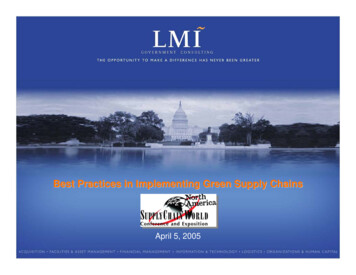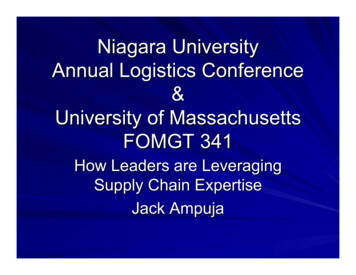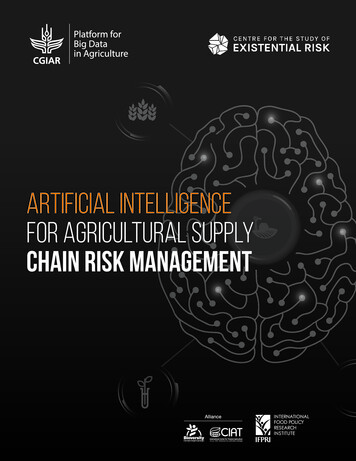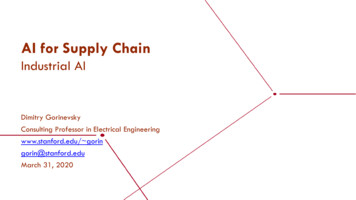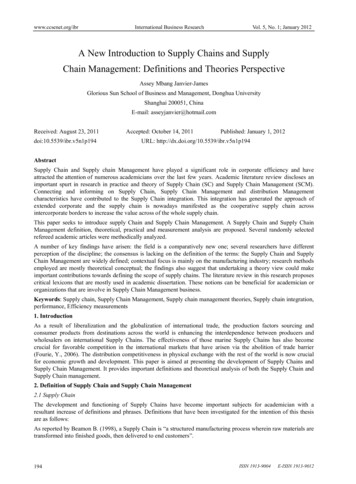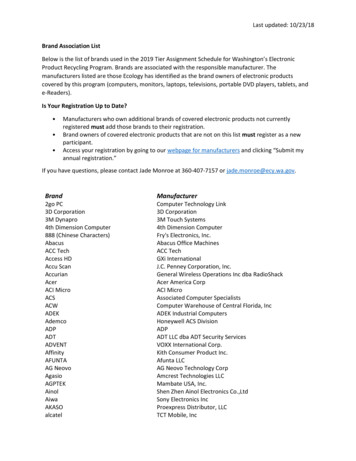
Transcription
Reliability ConsultingWhite PaperNovember 2018Supply Chain OptimizationMaintenance Repair and Operations (MRO) supply chain, when given serious consideration at all, is frequently seen as a challenge—a high-cost, but necessary evil to ensure the availability of parts that support equipment reliability. Among the challenges areintegrating end-to-end planning, increasing reliability/availability of physical assets, optimizing inventory, and realizing effectivespend management. Firms that have met these challenges have found MRO supply chain to be an opportunity to dramaticallyreduce costs while improving asset reliability. This paper provides an overview of some common challenges and effective solutions.Historically, MRO has been seen as a low-value, indirect supply chain with little investment in developing new processes and/orsystems. Recently, however, as gains have been squeezed from other options, MRO is increasingly being seen as an opportunityto drive further enhancements. Concurrently, system and outsource service providers have evolved new approaches to this segmentof the business.In the current business environment, most firms are striving to increase operational availability of their physical assets against abackdrop of unrelenting pressure to reduce costs and improve profitability. Of all the initiatives that an organization could pursueto achieve these aims, optimizing the MRO supply chain is one of the best options available for reducing costs and unlocking value.
Top Five Maintenance & Reliability Enablersfor Improved Operational PerformanceNovember 2018ChallengesInaccurate and Incomplete Master DataMaster data management is one of the most important MRO supply chain activities and is the foundation for effective planning andexecution functions. Following are key master data elements in MRO supply chain.Asset MasterThe asset master is one of the most important data elements in MRO supply chain management. More often than not, the Asset Billof Material (BOM) and spare part linkages are not defined, which leads to inefficient inventory planning, high level of obsolescence,unavailability of the right spares at the right time, and ultimately higher maintenance costs. Other missing or incomplete detailsin the asset master, such as asset hierarchy and related assets, leads to missed opportunities for maintenance personnel to makerepairs and perform upkeep when equipment is down.Incomplete or Inaccurate Task ListsMaintenance task lists are important elements of maintenance plans and work orders. Once the task lists are defined along withthe BOM, the task lists help in automating the end-to-end process from planning through execution and help in planning neededmaterial in advance. If task lists are incomplete or inaccurate, they may interfere with material planning, requisition, and reservationprocesses, thereby delaying or causing planned/scheduled maintenance to be missed altogether.Parts CatalogOften unappreciated in MRO supply chain management is the fact that there are typically thousands of parts in the systemwith each having unique characteristics and attributes. Proper, structured cataloging of these parts is both a requirementand a challenge. Inaccurate and incomplete cataloging leads to: Difficulty for the end user (e.g. Planner) to find the right material Duplication of Stock Keeping Unit (SKU) codes Increased stock outs due to duplication Increased inventory due to duplicationwww.emerson.com/opcertcon2
Top Five Maintenance & Reliability Enablersfor Improved Operational PerformanceNovember 2018Lack of integration of MRO Supply Chain and MaintenanceMRO supply chain is comprised of three functions—Asset Management, Inventory Management, and Sourcing & Procurement. Inmost organizations, these are viewed in functional silos. Although many of these same organizations do integrate within functionalprocesses such as work-order execution, purchase requisitions, inventory management, and purchase order processing, lessattention has been paid to integrating end-to-end processes across functions from planning through execution across all MROsupply chain functions. A lack of integrated planning specifically leads to suboptimal inventory management, higher procurementcosts, and higher unavailability of assets.Lack of Demand Visibility from Maintenance PlansPerhaps the most challenging consequence of not integrating Maintenance plans and MRO supply chain is inability to forecastdemand. Asset maintenance, being the demand driver, presents two types of demand in the MRO supply chain—Planned andUnplanned. Planned demand arises out of planned preventive/predictive maintenance plans, corrective repairs identified frompreventive/predictive inspections, shutdown plans, and field change orders where material needs can be seen in advance.Unplanned demand arises from breakdowns and other unplanned maintenance. Whereas demand visibility provides an opportunityfor the MRO supply chain to provide needed material in a timely and efficient manner, the demand is not visible if the plans arenot developed in the ERP or CMMS system or if maintenance personnel conduct planning or work order management manuallyoutside the associated system without capturing the needed information. Reduced visibility of demand adversely impacts inventorymanagement and sourcing processes, leading to higher costs throughout the supply chain.www.emerson.com/opcertcon3
Top Five Maintenance & Reliability Enablersfor Improved Operational PerformanceNovember 2018Difficulty Managing InventoryMRO inventories are characterized by large numbers of SKUs, different attributes, and highly variable demand ranging from rarelyused items to high-volume items. Criticality and demand variability further complicate the inventory planning process. All thesefactors require highly skilled resources for planning and to set the appropriate stocking policy. Few ERP or CMMS systems come withdynamic inventory planning features, adding to the difficulty of inventory planning. Due to these planning difficulties, the followingproblems often arise: Suboptimal inventories: Ranging from too high for some parts to unavailability or low inventory for others High inventory levels greater than industry benchmarks: Typically 0.3 to 1.5% of Replacement Asset Value (RAV) dependingon the industry Lower service levels Higher level of non-moving or obsolete parts Assets under-maintained for longer intervals due to unavailable partsFragmented Supply BaseFragmented supply base across categories is another challenge. With multiple locations and decentralized procurement processes,the supply base is inevitably even more fragmented. There may be multiple entries or codes for the same vendor, making it difficultto monitor and manage spend across vendors. These conditions limit the opportunity to leverage the spend value with vendors toget the most competitive pricing and favorable terms, such as shortened lead times. This, in turn, leads to increased need for safetystock on key materials and high purchase order processing costs.Complex and Non-Uniform Procurement ProcessesValue of MRO materials varies significantly, as does the associated procurement and approval processes. It has been frequentlyobserved that approval and procurement processes vary widely between sites within the same organization. Complexity inprocurement processes increases the internal lead time, which increases the need for safety stock of materials and adds to purchaseorder processing costs.www.emerson.com/opcertcon4
Top Five Maintenance & Reliability Enablersfor Improved Operational PerformanceNovember 2018Approaches to Optimizing MRO Supply ChainWith an understanding of the challenges present in the supply chain, we can define approaches to improve effectiveness and reducecosts associated with ensuring availability of MRO parts.Focus on Master Data ManagementMaster data, one of the most critical elements of the MRO supply chain, must be managed effectively. Businesses assume thattheir data is accurate with respect to the simple identification of parts and assets. Unfortunately, this is often not the case. Everystoreroom has duplicate parts—same parts with different identifications. Such duplication promotes excess holdings and can alsocreate apparent part shortages when one part name is needed but not held—and conversely, the same part is on-hand but undera different ID.One of the initial steps of any MRO optimization initiative is data cleansing. To maximize return on investment, asset and inventorydata must be accurate and in a standardized form. Companies should begin by building databases that ensure the integrity andaccuracy of inventory information. With accurate and reliable database information, companies can maintain lower inventory levelsand create data-driven purchasing.Organizations should also review the existing master data management processes and systems, apply discipline to the entireprocess, and focus on improving the quality of master data for assets, suppliers, parts catalogs, part categorization, maintenancetask lists, and part and asset BOM linkages on an ongoing basis. If data is being managed in multiple locations and systems, thenconsideration should be given to moving this function to a centralized location or even outsourcing to a specialized service provider.Benefits of centralizing master data management include increased accuracy and standardization of the data set and accountabilityof the data team.Since better data helps eliminate costs and improve profits, how do companies improve their MRO item data? It may seem like anoverwhelming task, but by breaking the task into defined, manageable steps, it can be achievedData CleansingCleansing and structuring the data is the first step. Many MRO item descriptions are stored as unstructured, free-form text.Converting these text-based descriptions into structured data based on a set of standard modifiers provides many benefits: Structured data forms the baseline information for developing a robust MRO catalog Duplicate data can start to be recognized and reduced Structured data is more readily searched, allowing technicians and purchasing agents to find parts quickly Enterprise Resource Planning (ERP) and Enterprise Asset Management (EAM) systems are able to make better useof structured dataData StandardizationOnce the data is in a structured format, it can be standardized. This second step ensures consistent and accurate information, whichleads to inventory optimization in the following ways: Possible duplicate parts can be identified. Redundant parts can be eliminated and inventories reduced Improved accuracy ensures the right part is selected every time Everyone has access to the same information Improved tracking ability means better forecasting Better planning reduces overstocking, false stock outs, and excessive shipping costs Procurement personnel can order MRO parts proactively, thus taking advantage of strategic pricing agreementswww.emerson.com/opcertcon5
Top Five Maintenance & Reliability Enablersfor Improved Operational PerformanceNovember 2018Standardizing data further builds upon the benefits of structuring the data as well. Searching, ERP/EAM effectiveness, and catalogdevelopment are all enhanced with consistent, accurate data.Data EnrichmentThe final step is to enrich the data with as much information as possible. Doing this provides the following benefits: Valuable characteristics provide of all the information that is needed for technicians, engineers, and purchasing professionals With this information, a thorough evaluation of possible duplicates can be undertaken to reduce inventory and decreasecarrying costs With this level of detailed, value-added information, decisions can be made about the interchangeability of parts to all buteliminate duplicate partsInterchangeability allows for easier procurement. If an item part cannot be easily supplied by a vendor, another interchangeableitem can be used, or if a certain item is not in stock, an interchangeable one can be used, allowing the plant to keepingrunning smoothly.The enrichment process builds on the benefits of the first two steps in the following ways: A robust MRO catalog can now be built and accessed by all who need it Searching capabilities can be fully utilized Powerful ERP/EAM capabilities can be leveraged to solve MRO challengesOn one further note, the data standardization and enrichment phase of an MRO optimization initiative also offers the opportunityto shift plant asset and part identification nomenclature to industry standard terms. Many businesses change to UNSPSC (UniversalStandard Products and Services Classification) Coding for their items so that they are using the most current global electroniccommerce standard terminology, providing a standardized framework for classifying goods and services by commodity. In addition,some companies choose to enhance their item nomenclature during this phase so that part IDs are electronically matched usingmanufacturer name and part numbers. Parts listings are then reviewed and enhanced in accordance with industry standards(including UNSPSC coding as necessary).Integrated Maintenance and Procurement PlanningOnce the required master data is ready, the organization can assess the current state of planning processes, implement a welldefined process for annual and periodic maintenance planning based on reliability-centered practices, and ensure that the processesare followed by planning teams. Annual and periodic maintenance planning will be one of the inputs for annual and periodicinventory category planning. Benefits delivered under this approach include: Improved demand visibility, enabling procurement to obtain the right part at the right time—at the best possible priceand terms. Improved inventory planning, resulting in more appropriate total inventory investment. Improved service levels in areas such as parts availability at lower cost. Improved category planning and reduced cost of procurement.www.emerson.com/opcertcon6
Top Five Maintenance & Reliability Enablersfor Improved Operational PerformanceNovember 2018Inventory and Warehouse Management PracticesWith enhanced data and better integration of planning between Maintenance and Procurement, what remains is the applicationof effective practices to manage inventory and the storerooms.Process OffshoringFor particularly large operations, the organization can identify which of the associated processes can be consolidated on a globalscale and executed in lower-cost countries offshore. The business can then not only reduce processing costs but also benefitfrom the standardization and improved control attained by moving some of the processes to a centralized offshore location. Theprocesses suggested below can help the business drive efficiency and better manage some of MRO supply chain challenges. Master Data Management MRO Supply Chain Planning Asset Maintenance, Inventory, and Category Planning Parts Pooling Supply Base Rationalization Purchase Order Processing Disposal ManagementApply Scientific Inventory ModelsMRO supply chains are characterized by high parts counts and high variation in demand and part criticality. An inventoryplanning team can evaluate the stocking policies and update data such as required service levels for parts, criticality, anddemand predictability on an ongoing basis in consultation with end users. This team can design the assessment methodology,rules, and parameters to identify and measure criticality, service-level requirements, and demand predictability for specificparts. The team can then determine which will be stock and non-stock based on criticality and predictability among otherconsiderations such as usage, cost, and lead time. For example, a highly critical part with unpredictable demand would betreated as a stock item. Since usage patterns vary from rarely to often, the team can classify the SKUs based on usage andselect the right stocking models for each class of usage to define order points and quantities for stock items. The benefitsof statistically defining inventory models include: Optimized inventory—neither too high nor too low Improved service levels Ease in identifying unplanned demand Streamlined processesDispose of Unused and Obsolete StockAn inventory planning team can identify obsolete items by coordinating with the asset management team and periodically tagthe identified parts. Similarly, the inventory planning team can also identify and assess with end users non-moving parts for futureuse to tag such parts in the system. Once the non-moving and obsolete parts are identified, the teams can analyze the physicalcondition of the parts, markets where these could be sold, and supplier buy-back options and initiate the best actions from below. Coordinate with the supplier for buy back Find customers who may need the parts and sell to them Consign for sale to a third-party vendor or exchange operator If the parts are not serviceable, sell as scrapwww.emerson.com/opcertcon7
Top Five Maintenance & Reliability Enablersfor Improved Operational PerformanceNovember 2018By continually monitoring and managing stock, the business can recover at least some value in dead inventory that would otherwisebe written off or worse, carried on the books.Parts PoolingOrganizations with multiple locations and similar or same assets can reduce inventory of expensive parts and increase service levelsby parts pooling and inter-warehouse or location exchange programs. A centralized inventory planning team of the organization canplay a crucial role in the pooling process from identifying the pooling location, pooling stock, and pooling quantity to supportingthe locations in day-to-day transfers of stock.Warehouse Productivity and Inventory Accuracy ImprovementsA company must review its storeroom processes and procedures. A needs analysis should be conducted to help define optimalmethods for performing inventory checkouts, returns, physical valuations, and purchasing procedures. The goal is to establishbaselines using an Industry Metrics & Best Practices approach. This means measuring performance against proven quality standardsthat streamline and strengthen inventory practices. This streamlining is not done in a vacuum; it requires participation by allstakeholders and includes: Meetings between maintenance, purchasing, and IT personnel Reviews of storeroom and inventory locations to assess management methods Evaluations of maintenance, repairs, and operations parts inventory/purchasing databasesThe ideal result here should be the establishment of the optimum storeroom setup and recommendations for changing storeroomlayout for better productivity. These steps provide a clear path for bringing structure and discipline to a company’s data andinventory management processes.A business builds a storeroom organization plan by electronically organizing inventory into commodity groups. The commoditygroups can include bearings, electrical parts, pipes, valves, fittings, air and hydraulics, industrial supplies, instrumentation, OriginalEquipment Manufacturer (OEM) supplies, and the like. Organizing the storeroom helps companies save time and capital, ensuringthe right parts are on-hand and eliminating surplus and obsolete inventory. Several approaches include: Group the materials with respect to size, shape, and physical storage requirements and keep the same material groupin a designated single location Identify parts that need preservation (e.g. lubrication and turning of motors) followed by development and implementationof a preservation plan that will ensure parts are in usable condition when needed Store small items more easily removed without control (e.g. batteries, adhesives, consumables, etc.) under lock and key Monitor and improve “goods receipt to storage location” and “requisition to delivery” cycle timesAdditional actions that will help to ensure accuracy of inventory include: Periodic location auditing and implementation of preventive measures to reduce location discrepancy Review existing cycle counting practices and audit preventive measureswww.emerson.com/opcertcon8
Top Five Maintenance & Reliability Enablersfor Improved Operational PerformanceNovember 2018Manage Supply and ProcurementRationalize the Supply BaseA company takes its cleansed data a step further by analyzing items to determine minimum inventory levels, existing excessinventory, recommended active inventory, and obsolete items. In addition, parts spending can be analyzed based on supplier,commodity type, and stock versus non-stock classification to identify supplier consolidation opportunities. Spend analysis involvesidentifying vendor market share by commodity group based on dollar amount and Stock Keeping Unit (SKU) to help companiesnegotiate better corporate-wide unit-cost reductions. This means patronizing fewer suppliers—and dealing on a volume basis withvendors providing the majority of parts and inventory items. Organizations can leverage the value of their MRO spend throughspecification standardization of SKUs, consolidation of procurement spend across multiple locations, cleansing of supplier masterdata, elimination of non-performing suppliers, and rationalization of the supplier base. The advantages include: Reduced cost of procurement Favorable terms with suppliers, such as reduced lead time and support from vendor for return of excess stockand obsolete material Reduced inventories due to standardized specifications and reduced lead timesImproved Procurement ProcessesOne characteristic of MRO supply chains is high counts of purchase requisitions leading to high counts of Purchase Order (PO)generation and processing. PO processing and post order expediting are highly cumbersome and transactional in nature. Theseactivities consume most of the time of procurement personnel leaving limited time to focus on the more strategic aspects ofsourcing. Among these more strategic activities, the organization can review the existing annual spend based on part criticality,cost, and supply source and then simplify and automate procurement processes and select the most suitable procurement methodsby class or item.For example, organizations can cover the maximum numbers of critical parts under pre-negotiated contracts and simplify thetactical procurement process by reducing the numbers of approval levels for PO releases for parts against these pre-negotiatedcontracts. Simplification and automation in procurement processes will help reduce procurement lead times and cost.ConclusionDespite being highly complex and time consuming, managing to optimize the MRO supply chain can yield significant benefitsincluding low procurement cost, optimized inventory levels, and greater operating availability of assets. 2017-2018, Emerson. All rights reserved.EmersonReliability Consulting1100 Louis Henna BlvdRound Rock, TX 78681 USA 1 888 889 9170www.emerson.com/opcertconThe Emerson logo is a trademark and service mark of Emerson Electric Co. All other marks are theproperty of their respective owners.The contents of this publication are presented for informational purposes only, and while every efforthas been made to ensure their accuracy, they are not to be construed as warranties or guarantees,express or implied, regarding the products or services described herein or their use or applicability.All sales are governed by our terms and conditions, which are available on request. We reserve theright to modify or improve the designs or specifications of our products at any time without notice.
Master data management is one of the most important MRO supply chain activities and is the foundation for effective planning and execution functions. Following are key master data elements in MRO supply chain. Asset Master The asset master is one of the most important data elements in MRO supply chain management.




